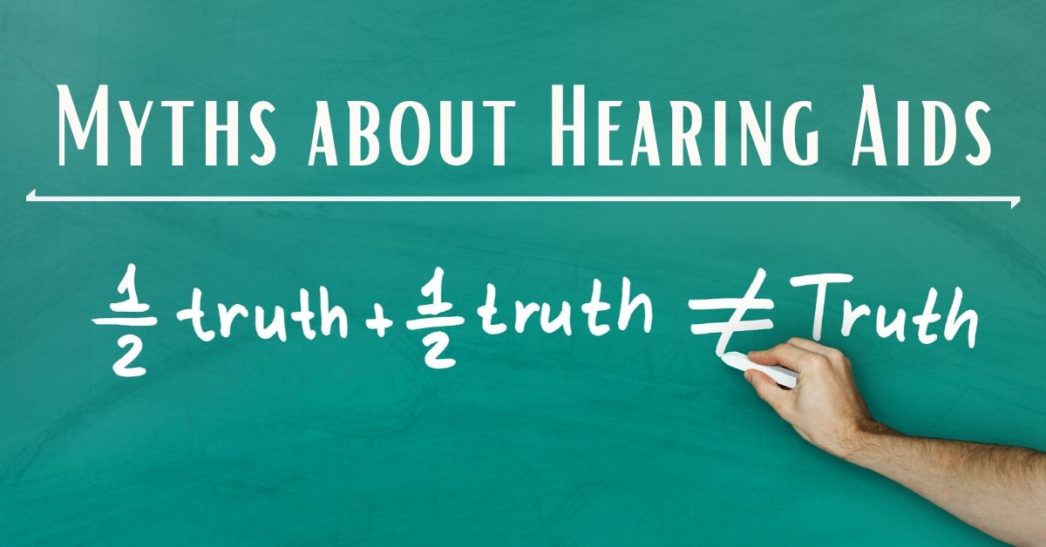Have you been considering hearing aids, but can’t imagine wearing one? You’re probably picturing a large, clunky hearing aid, like the one your uncle used to wear. It only helped some of the time, and it often had a lot of feedback. Modern hearing aids have improved, and are almost unrecognizable from the hearing aids of the past. As you weigh your hearing aid options, here are some of the myths about hearing aids.
Myth: Hearing Aids Are Only for Seniors
Whether you’re young in years or young at heart, you don’t want a device that makes you feel old. If you’re imagining an unwieldy device, you’re probably not going to want to get hearing aids. However, comparing modern hearing aids to hearing aids of even 15 years ago is like comparing your newest cell phone to your old rotary phone. The comparison is almost unimaginable.
Modern hearing aids are sophisticated devices that are designed to help you hear clearly in a variety of listening environments. Sleek devices can be tucked behind the ear, and some will sit in the ear, in the canal, or even past the bend in the ear canal, making them invisible! Not only that, but most modern hearing aids can be synced to your phone, so you can switch between programs and settings or adjust the volume easily and discreetly.
Myth: Hearing Aids Are for Severe Hearing Loss
It’s true that people with severe hearing loss should wear hearing aids. But if you have mild or moderate hearing loss, you’ll also benefit from hearing aids! Think about it this way. If you have a hard time focusing when reading your morning newspaper, you’ll likely rush to get a vision test, and start wearing glasses so you can enjoy seeing clearly. Hearing aids are the same way. As soon as sounds start getting fuzzy, you struggle to follow conversations, or ask people to repeat themselves, you need to get a hearing test. Hearing aids will help you hear clearly in many listening situations, and you won’t have to struggle with hearing loss in your daily life or relationships.
Myth: Hearing Aids Won’t Manage My Tinnitus
If you’ve been struggling with tinnitus, that annoying ringing or buzzing sound in your ear, hearing aids provide a great solution! Modern hearing devices can be programmed with tinnitus therapy features and sound therapy. With the tap of a button you’ll be able to engage the sound masking program, and watch as your tinnitus fades into the background.
Myth: Hearing Aids Will Work Immediately
You should approach getting hearing aids the same way you approach getting glasses, but the similarity ends there. When you get glasses, your eyes automatically adjust, and you’ll be seeing clearly immediately. Hearing aids are a bit more complicated. Hearing devices analyze the sounds around you, amplify important sounds, and reduce background noise. The sound quality will change, and your ear needs some time to adjust to this new way of hearing. Not only that, but as hearing aids allow you to hear sounds you haven’t heard in years, the cells in your ears and brain must relearn how to hear this sound. Hearing aids will work, but you’ll need to give yourself a week or two to adjust to your new technology.
Myth: I Can Skip the Follow-up Appointment
You may think that after you have the hearing aids, you don’t need to go to any follow-up appointments. During the initial fitting, the hearing aids will be programmed to match your unique hearing loss, but follow-up visits are essential to making sure the hearing aids are comfortable, calibrated correctly, and providing you with the best hearing. Follow-up visits are also a chance for you to ask any questions you may have after wearing the devices for a couple weeks, and they allow your hearing health specialist to re-check that the devices are working optimally.
Myth: I Could be Stuck with the Wrong Hearing Aids
Hearing aids are an investment, and you may be worried you’ll make the wrong decision. Most hearing health specialists allow a trial period, where you can take the devices home for a few days and try them out for yourself. This trial pair won’t fit exactly as the custom-molded device you’ll get when you decide to purchase the hearing aid, but it will provide a good example of everything the hearing aid will be able to do for you, and give you confidence in your decision.


